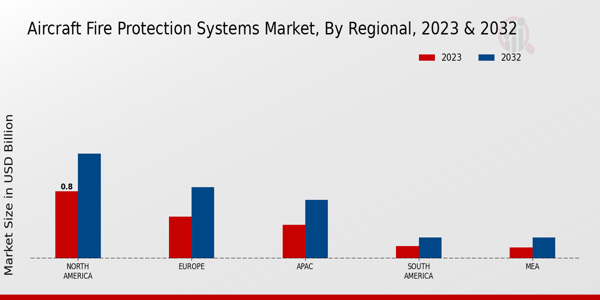Market Share
Introduction: Navigating the Competitive Landscape of Aircraft Fire Protection Systems
The aircraft fire protection system market is undergoing a significant transformation, owing to the rapid technological advancements, stringent regulatory frameworks, and increased passenger safety expectations. The leading players in this market, including system manufacturers, IT service providers, and system integration companies, are vying with one another to leverage advanced technology such as AI-based analytics, IoT integration, and automation. In order to develop such advanced solutions, the system manufacturers are focusing on designing products that are safe and efficient, while the IT service and system integration companies are developing sophisticated data management and analytics solutions to optimize the performance of these systems. However, the emerging players, particularly the AI-based startups, are introducing advanced solutions that are redefining the existing paradigms of fire protection. Moreover, as the industry is moving towards a sustainable future, the green initiatives are becoming the key differentiators. Among the regions, the Asia-Pacific and North America are likely to emerge as the most lucrative markets, owing to the stringent regulatory requirements and the increasing demand for advanced solutions.
Competitive Positioning
Full-Suite Integrators
These vendors provide comprehensive solutions integrating various fire protection technologies for aircraft.
| Vendor | Competitive Edge | Solution Focus | Regional Focus |
|---|---|---|---|
| Boeing | Industry leader with extensive aerospace experience | Integrated fire protection systems | Global |
| Airbus | Innovative designs and advanced technology integration | Fire protection systems for commercial aircraft | Global |
| Honeywell International | Diverse technology portfolio and global reach | Fire detection and suppression systems | Global |
| UTC Aerospace Systems | Strong focus on aerospace safety solutions | Fire protection and safety systems | Global |
Specialized Technology Vendors
These vendors focus on niche technologies and innovations in fire protection systems.
| Vendor | Competitive Edge | Solution Focus | Regional Focus |
|---|---|---|---|
| Eaton Corporation | Advanced electrical and fire protection technologies | Fire suppression and detection systems | North America, Europe |
| Tyco International | Expertise in fire safety and security solutions | Fire protection systems and services | Global |
| Chemring Group | Specialized in advanced fire protection technologies | Fire suppression systems | Global |
| Leonardo S.p.A. | Strong defense and aerospace capabilities | Fire protection systems for military aircraft | Europe, North America |
Infrastructure & Equipment Providers
These vendors supply essential components and systems for fire protection in aircraft.
| Vendor | Competitive Edge | Solution Focus | Regional Focus |
|---|---|---|---|
| Parker Hannifin Corporation | Expertise in motion and control technologies | Fire protection equipment and systems | Global |
| Woodward Inc. | Precision control solutions for aerospace applications | Fire protection and control systems | North America, Europe |
| Rheinmetall AG | Strong defense technology integration | Fire protection systems for military applications | Europe, Asia |
| Hampson Industries | Specialized in aerospace component manufacturing | Fire protection components | North America, Europe |
| General Electric | Innovative technology and engineering expertise | Fire protection systems and components | Global |
Aerospace Manufacturers
These vendors are major aircraft manufacturers that integrate fire protection systems into their aircraft designs.
| Vendor | Competitive Edge | Solution Focus | Regional Focus |
|---|---|---|---|
| Zodiac Aerospace | Expertise in aircraft systems and components | Fire protection systems for aircraft | Global |
| Safran | Strong focus on aerospace and defense technologies | Fire protection and safety systems | Global |
Emerging Players & Regional Champions
- Firetrace International (USA): Specializes in automatic fire extinguishing systems for aircraft. Recently received a contract from a regional carrier for the retrofitting of old aircraft. By offering cost-effective and easy-to-install solutions, it is taking on established suppliers.
- Kidde Aerospace (USA): Offers advanced fire detection and suppression systems, recently implemented a new system for a major aircraft manufacturer, complementing established vendors by providing innovative technology that enhances safety features.
- Zodiac Aerospace (France): specializes in integrated fire protection systems, recently entered into a contract with a European airline for a fleet renewal, and is establishing itself as a regional champion by taking advantage of its local manufacturing capabilities to reduce lead times.
- AeroFire (Canada): Develops lightweight fire suppression systems tailored for small aircraft, recently launched a new product line aimed at general aviation, challenging larger vendors by focusing on niche markets with specific needs.
Regional Trends: In 2023, a noticeable trend was observed in the development of light and inexpensive fire-prevention systems, especially in North America and Europe. This is due to the fact that the emerging companies are increasingly collaborating with the established companies in order to increase the safety features of their products. There is a growing trend towards the retrofitting of older aircraft with modern fire-prevention technology, which is being driven by the demands of the authorities and the requirements of safety standards.
Collaborations & M&A Movements
- Honeywell and Safran formed a partnership to develop next-generation fire detection systems for commercial aircraft, aiming to enhance safety standards and reduce operational costs.
- UTC Aerospace Systems acquired the fire protection division of Meggitt PLC to strengthen its portfolio in aircraft safety technologies and increase market share in the aerospace sector.
- Boeing and Airbus entered a collaboration to jointly research advanced fire suppression technologies, focusing on sustainability and compliance with evolving regulatory standards.
Competitive Summary Table
| Capability | Leading Players | Remarks |
|---|---|---|
| Fire Detection Systems | Honeywell, UTC Aerospace Systems | Honeywell’s smoke-detection equipment has been widely adopted by commercial aircraft, thereby improving safety procedures. UTC Aerospace Systems offers integrated fire-detection and fire-suppression systems that have been successfully integrated into a variety of aircraft models and have demonstrated their reliability. |
| Fire Suppression Systems | Boeing, Kidde | The lightness and efficiency of the fire-suppression system, thanks to advanced materials, is one of the reasons why it saves fuel. With its Halon-replacing systems, Kidde is gaining a strong position in the market, thanks to the resulting compliance with the environment. |
| Data Analytics for Fire Safety | Thales, Rockwell Collins | Thales has combined its fire-extinguishing systems with a data-analytics programme, which enables them to be remotely supervised and their maintenance needs to be predicted, thus improving operational safety. Rockwell-Collins has been able to demonstrate the effectiveness of its fire-prevention systems by reducing the number of fires in recent case studies. |
| Regulatory Compliance | Safran, Airbus | Regulatory compliance is guaranteed by Safran systems. Airbus has developed complete fire-prevention systems that meet international standards and are therefore the preferred choice of many operators. |
| Sustainability Initiatives | GKN Aerospace, Northrop Grumman | GKN Aerospace is concentrating on the development of fire-protection systems using sustainable materials, and this has been well received in the market. Northrop Grumman is investing in the development of fire-suppression systems using natural materials, in line with the industry’s trend towards greater responsibility. |
Conclusion: Navigating Competitive Dynamics in 2023
The market for aircraft fire protection in 2023 is characterized by strong competition and fragmentation. The market is divided into established and new players. Regional trends point to a growing focus on stricter safety regulations, which in turn lead to innovations and adaptations by the suppliers. The established players are able to take advantage of their reputation and distribution network. The new players are able to focus on the latest technology, such as artificial intelligence and automation, to improve the efficiency and reliability of the systems. Strategic recommendations for suppliers include investing in long-term and flexible solutions. In the future, cooperation and technological development will be key factors for success in the competitive market.











Leave a Comment